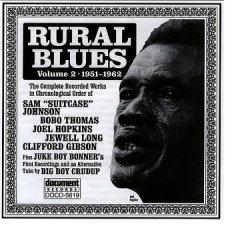Rural Blues Vol. 2 (1951-1962) (1998)
Rural Blues Vol. 2 (1951-1962) (1998)

01. Sam 'Suitcase' Johnson - Sam's Comin' Home (2:46) 02. Sam 'Suitcase' Johnson - Sam's Boogie (2:25) 03. Bobo Thomas - Catfish Blues (I Wish I Was A Catfish) (2:57) 04. Clifford Gibson - Sneaky Groundhog (3:02) 05. Clifford Gibson - Let Me Be Your Handy Man (3:02) 06. Juke Boy Bonner - Rock With Me Baby (2:54) 07. Juke Boy Bonner - Well Baby (2:28) 08. Joel Hopkins - Good Times Here, Better Down The Road (3:13) 09. Joel Hopkins - Thunder In Germany (8:15) 10. Joel Hopkins - I Ain't Gonna Roll For The Big Hat Man No More (5:42) 11. Joel Hopkins - Accused Me Of Forgin', Can't Even Write My Name (5:16) 12. Joel Hopkins - Matchbox Blues (1:54) 13. Jewell Long - Frankie And Albert (3:23) 14. Jewell Long - My Pony Run Blues (2:51) 15. Jewell Long - Sealy Rag (2:17) 16. Jewell Long - Muddy Shoes Blues (3:27) 17. Clifford Gibson - It's Best To Know Who You're Talking To (3:10) 18. Clifford Gibson - I Don't Want No Woman (3:15) 19. Clifford Gibson - The Monkey Likes To Boogie (2:30) 20. Clifford Gibson - No Success Blues (2:56) 21. Arthur 'Big Boy' Crudup - Angel Child (Take 2) (5:25)
The rural blues developed in three principal regions, Georgia and the Carolinas, Texas, and Mississippi. The blues of Georgia and the Carolinas is noted for its clarity of enunciation and regularity of rhythm. Influenced by ragtime and white folk music, it is more melodic than the Texas and Mississippi styles. Blind Willie McTell and Blind Boy Fuller were representative of this style. The Texas blues is characterized by high, clear singing accompanied by supple guitar lines that consist typically of single-string picked arpeggios rather than strummed chords. Blind Lemon Jefferson was by far the most influential Texas bluesman. Mississippi Delta blues is the most intense of the three styles and has been the most influential. Vocally, it is the most speech-like, and the guitar accompaniment is rhythmic and percussive; a slide or bottleneck is often used. The Mississippi style is represented by Charley Patton, Eddie (“Son”) House, and Robert Johnson, among others.
The first blues recordings were made in the 1920s by black women such as Mamie Smith, Ma Rainey, Ida Cox, and Bessie Smith. These performers were primarily stage singers backed by jazz bands; their style is known as classic blues.
The Great Depression and the World Wars caused the geographic dispersal of the blues as millions of blacks left the South for the cities of the North. The blues became adapted to the more sophisticated urban environment. Lyrics took up urban themes, and the blues ensemble developed as the solo bluesman was joined by a pianist or harmonica player and then by a rhythm section consisting of bass and drums. The electric guitar and the amplified harmonica created a driving sound of great rhythmic and emotional intensity. ---britannica.com
download (mp3 @320 kbs):
yandex 4shared mega mediafire cloudmailru gett uplea








